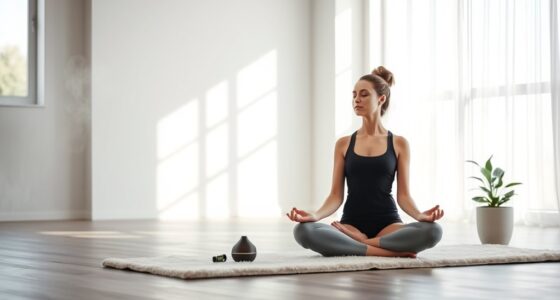Art offers powerful therapeutic benefits that can boost your emotional well-being, reduce stress, and support physical health. Engaging in creative activities helps you process feelings, boost self-esteem, and develop resilience. It can also improve brain function, aid in pain management, and promote relaxation. Whether you’re seeking personal growth or managing health challenges, understanding how art heals can open new paths to emotional and physical wellness—continue to discover how art can transform your life.
Key Takeaways
- Artistic expression promotes emotional healing, self-awareness, and reduces anxiety through safe exploration of inner experiences.
- Engaging in art activities lowers stress hormones like cortisol, fostering relaxation and emotional regulation.
- Art supports physical health by managing pain, improving motor skills, and aiding recovery processes.
- Regular creative practice enhances brain function, including memory, perception, and neuroplasticity.
- Art therapy benefits diverse populations by improving mental health, cognitive abilities, and emotional resilience across all ages.
Understanding the Foundations of Art Therapy
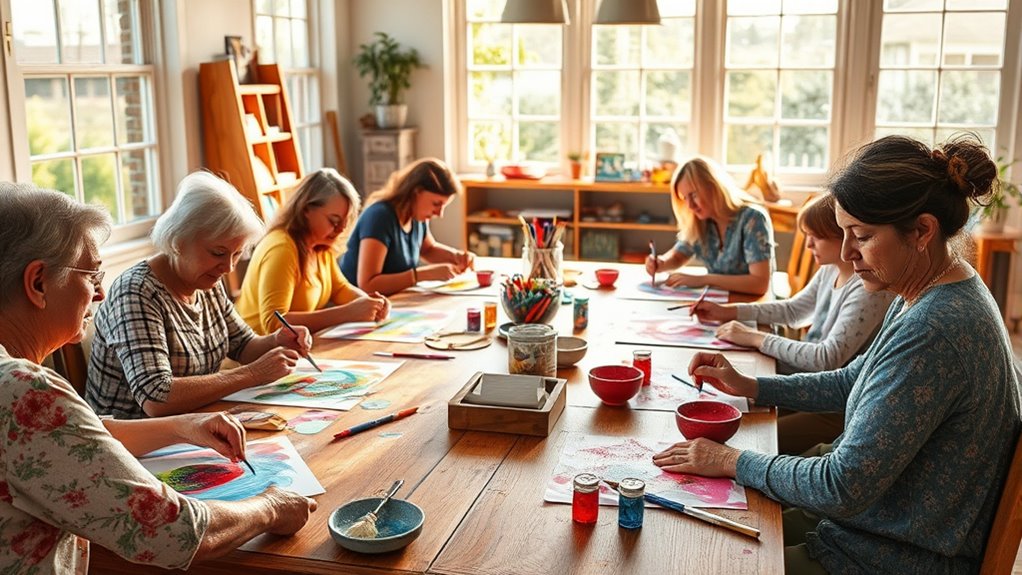
Understanding the foundations of art therapy begins with recognizing it as a formal psychotherapy practice that uses creative media like drawing, painting, and sculpture to promote healing. By combining mental health treatment with creative expression, you engage both your mind and emotions in a unique way. Licensed professionals with advanced degrees oversee art therapy, ensuring it’s a credible and effective approach. This practice isn’t limited to one setting; you might find it in hospitals, schools, or community clinics, tailored to different populations and cultural backgrounds. Scientific research supports its benefits, showing that art therapy can reduce stress, improve mental health, and foster recovery. Incorporating textile art techniques into therapy sessions has shown promising results in enhancing emotional expression and tactile engagement. Additionally, understanding the regulatory framework surrounding art therapy helps ensure that practitioners maintain high standards of care. Recognizing the importance of color accuracy in creative modalities can further enhance therapeutic outcomes. Moreover, the integration of various decorative techniques like painting and mixed media enriches the expressive possibilities within therapy sessions, making them more engaging and effective. For example, understanding artwork shelf life and proper storage can help clients maintain their art projects and continue their healing process outside of sessions. Ultimately, it’s a structured way to explore and heal through creative expression.
How Creative Expression Promotes Emotional Well-Being
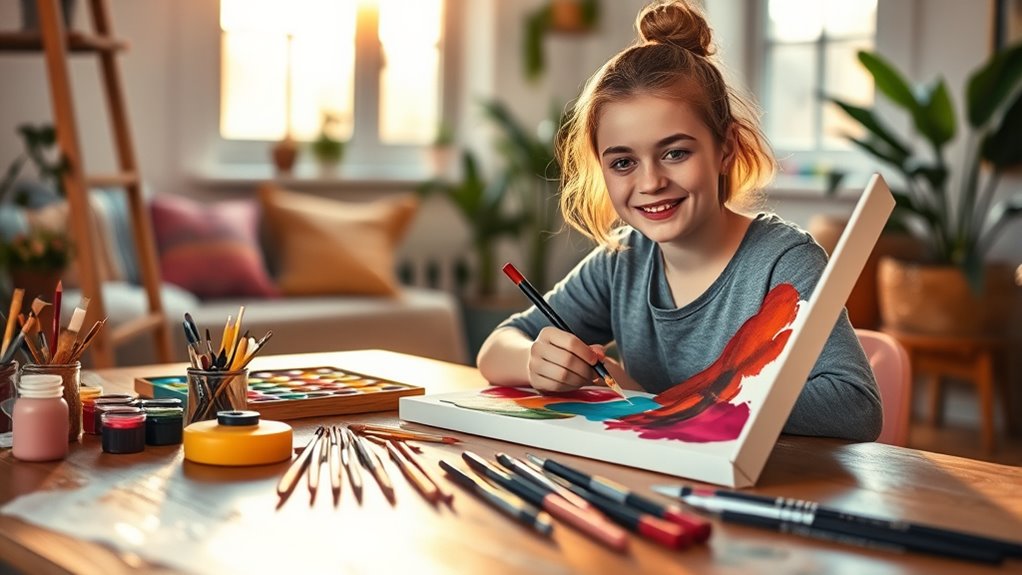
When you express your emotions freely through art, you create a safe space to process complex feelings and gain emotional clarity. Engaging in creative activities can boost your self-esteem and lift your mood naturally by increasing serotonin levels. As you regularly make art, you’ll notice a reduction in anxiety and a stronger sense of hope and resilience. Practicing self-reflection through art can deepen your understanding of personal challenges and foster emotional healing. Incorporating mindful meditative techniques into your artistic process can further enhance emotional balance and mental clarity. Exploring different artistic genres can also inspire new ways to connect with your emotions and promote overall well-being. Being aware of resources and tools available for emotional support can enhance your creative journey and provide additional avenues for healing. Additionally, engaging with artistic communities can offer encouragement and shared understanding, enriching your emotional growth.
Expressing Emotions Freely
Have you ever felt overwhelmed by emotions that words just can’t capture? Creative expression lets you process and release these feelings, promoting emotional relief. When you engage in the creative process, you explore your inner world safely, increasing self-awareness and emotional insight. Art provides a non-judgmental outlet, making emotional expression easier and more authentic. This active process strengthens emotional resilience, helping you manage future stress more effectively. The table below highlights how art impacts emotional well-being:
| Emotional Expression | Creative Process | Emotional Resilience |
|---|---|---|
| Releases pent-up feelings | Encourages self-discovery | Builds coping skills |
| Reduces anxiety | Fosters self-awareness | Enhances emotional stability |
| Eases depression | Promotes positive emotions | Supports ongoing regulation |
| Provides catharsis | Inspires insight | Strengthens inner strength |
| Boosts mood | Facilitates healing | Encourages growth |
Additionally, engaging in art therapy can be especially beneficial for developing these skills and promoting overall mental health. Incorporating creative activities into daily routines can further enhance emotional well-being and resilience. Recognizing the impact of emotional expression through art can also foster a greater appreciation for cultural differences and personal experiences. Developing emotional intelligence through creative pursuits can lead to deeper connections with others and increased empathy. Understanding the cost of art supplies can make engaging in creative pursuits more accessible and sustainable for everyone.
Building Self-Esteem
Engaging in creative activities naturally boosts your self-esteem by giving you a sense of achievement and mastery, no matter your artistic skill level. When you participate in art therapy or pursue creative expression, you develop a positive self-image and confidence in your emotional abilities. Completing art projects reinforces feelings of worth and builds emotional resilience. The act of creating allows you to explore and affirm your identity, promoting self-acceptance and reducing self-doubt. Regular involvement in art activates brain regions linked to reward and positive self-thoughts. Additionally, personal empowerment techniques like setting small, achievable goals during your creative process can further enhance your confidence and emotional well-being. Materials and techniques used in art can also influence your emotional well-being by fostering relaxation and focus. Incorporating mindset principles from the Law of Attraction can further amplify these benefits by aligning your thoughts with your creative intentions, fostering a more positive outlook. Recognizing the importance of emotional support can help reinforce the positive effects of creative expression on your mental health. Moreover, engaging in art can serve as a powerful form of stress relief, helping to lower anxiety levels and promote emotional balance.
Reducing Anxiety Naturally
Creative expression offers a natural way to ease anxiety and enhance emotional well-being. Engaging in art therapy or simply creating through drawing or painting can help reduce anxiety by lowering cortisol levels, which decreases stress. Incorporating regular art activities can amplify these benefits and create a calming routine. When you participate in creative activities, your brain releases positive neurotransmitters like serotonin, fostering a sense of calm and happiness. The process of making art activates your parasympathetic nervous system, helping to lower heart rate and blood pressure, alleviating anxiety symptoms. Focusing on your art redirects your attention away from anxious thoughts, promoting mindfulness and emotional regulation. Regular involvement in creative expression not only reduces negative emotions but also builds emotional resilience, making you better equipped to handle stress naturally. Additionally, embracing failure as a learning experience can foster resilience and encourage continued creative practice, further supporting emotional well-being. Engaging in mindful artistic practices can deepen emotional awareness and promote mental clarity. Incorporating art materials that stimulate sensory processing can also enhance relaxation and focus during creative sessions.
Physical Health Benefits of Engaging in Art Activities
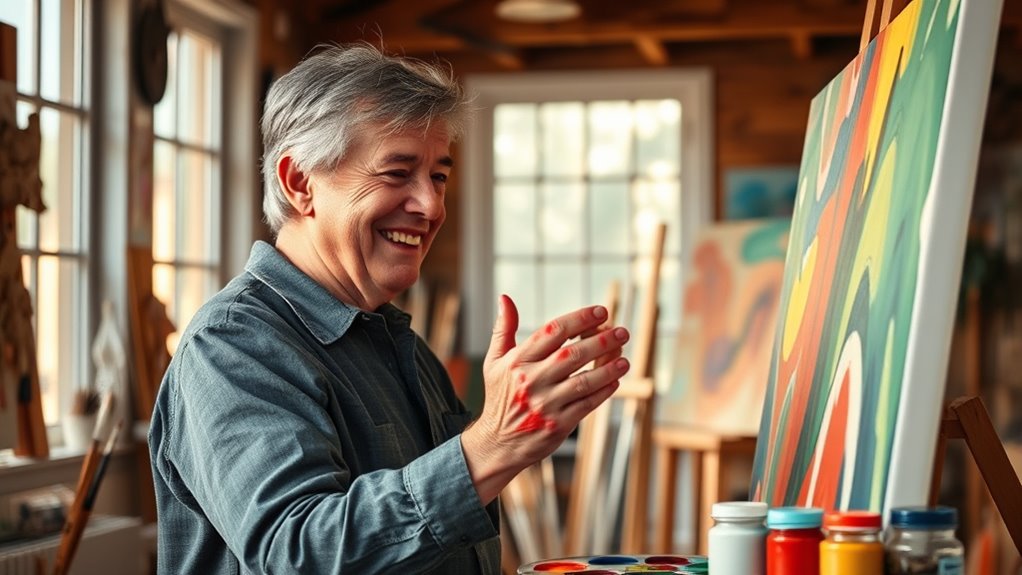
Engaging in art activities can help you manage pain and support physical recovery, making daily life more manageable. For cancer patients and others with health challenges, creative expression often improves overall comfort and well-being. Incorporating stress management techniques through art can further enhance mental relaxation and physical healing. Additionally, engaging in structured art projects can promote fine motor skills and coordination, aiding physical rehabilitation and mobility.
Pain Management Support
Have you ever noticed how focusing on creating art can ease physical discomfort? Engaging in art therapy helps lower perceived pain levels by promoting relaxation and distraction. It stimulates the release of endorphins, your body’s natural painkillers, improving pain management.
Additionally, art activities can decrease the need for pain medication in chronic illness cases like arthritis or cancer. Creating art also boosts emotional resilience, empowering you to better cope with physical pain and distressing symptoms.
Participating in visual arts encourages mindfulness and focus, which reduces stress responses and physical pain sensations. By integrating art into your routine, you can experience tangible benefits for managing pain and enhancing overall well-being.
- Promotes relaxation and distraction
- Releases endorphins, natural painkillers
- Decreases reliance on medication
- Strengthens emotional resilience
Enhancing Physical Recovery
Participating in art activities not only helps manage pain but also actively promotes physical recovery. Art therapy and creative arts engagement support healing by encouraging relaxation, which lowers stress hormones and improves sleep quality.
For stroke or injury patients, incorporating art-making into rehabilitation can enhance motor skills and coordination. Regular involvement in visual or tactile arts strengthens neural pathways responsible for sensory processing and motor control, speeding up recovery processes.
In addition, art therapy has proven effective for adult cancer patients, boosting physical functioning and overall well-being during treatment. By focusing on creative arts, you can facilitate physical recovery, reduce discomfort, and rebuild motor functions, making art a powerful tool in supporting your journey toward better physical health.
Improving Quality of Life
Incorporating art activities into your routine can considerably enhance your quality of life by promoting better physical health. Engaging in active art-making stimulates brain regions responsible for motor control and sensory processing, supporting physical rehabilitation and coordination. It also helps alleviate pain symptoms and improves physical comfort, especially for those with chronic illnesses.
Participating in visual arts can reduce stress, enhance emotional resilience, and positively impact mental health. Regular involvement in creative pursuits like painting or sculpting can strengthen fine motor skills and hand-eye coordination.
Additionally, integrating art into your health routine may decrease reliance on medication for pain and anxiety management.
- Boosts physical coordination and motor skills
- Reduces stress and enhances emotional resilience
- Supports physical rehabilitation
- Lowers medication dependence
The Role of Art Therapy in Managing Mental Health Conditions
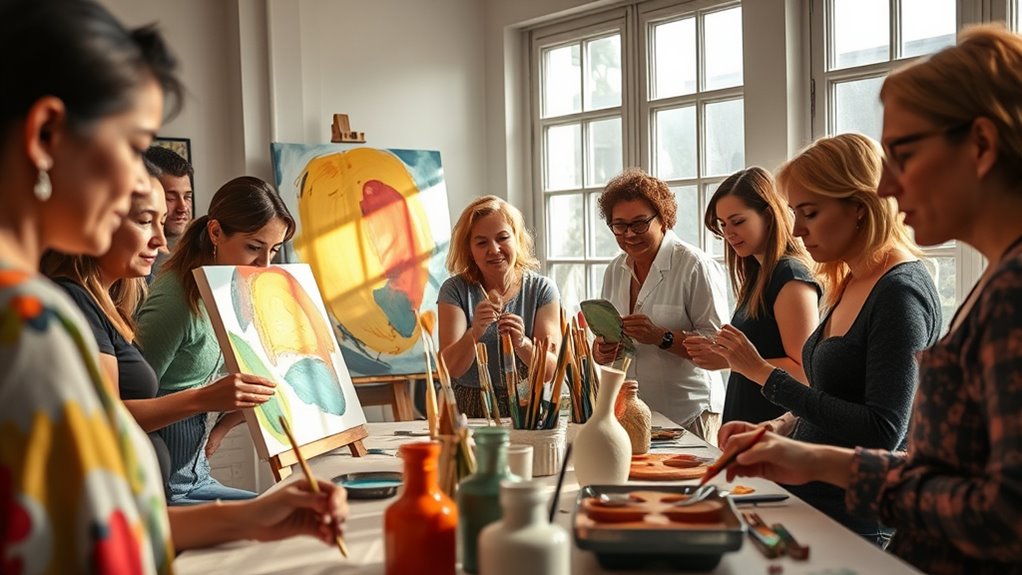
Art therapy plays an essential role in managing mental health conditions by providing a non-verbal outlet for emotional expression and processing. Through art therapy, you can better regulate your emotions, reducing symptoms of depression and anxiety.
Engaging in creative activities helps improve cognitive functioning and allows you to process traumatic experiences that are difficult to put into words. Participating in art therapy can decrease negative emotions and boost positive mood states, supporting overall mental health.
It also enhances self-awareness and insight, which are crucial for managing conditions like PTSD, schizophrenia, and mood disorders. When combined with traditional treatments, art therapy can improve treatment adherence and promote a more holistic path to mental health recovery.
Exploring Different Forms of Artistic Practice in Therapy
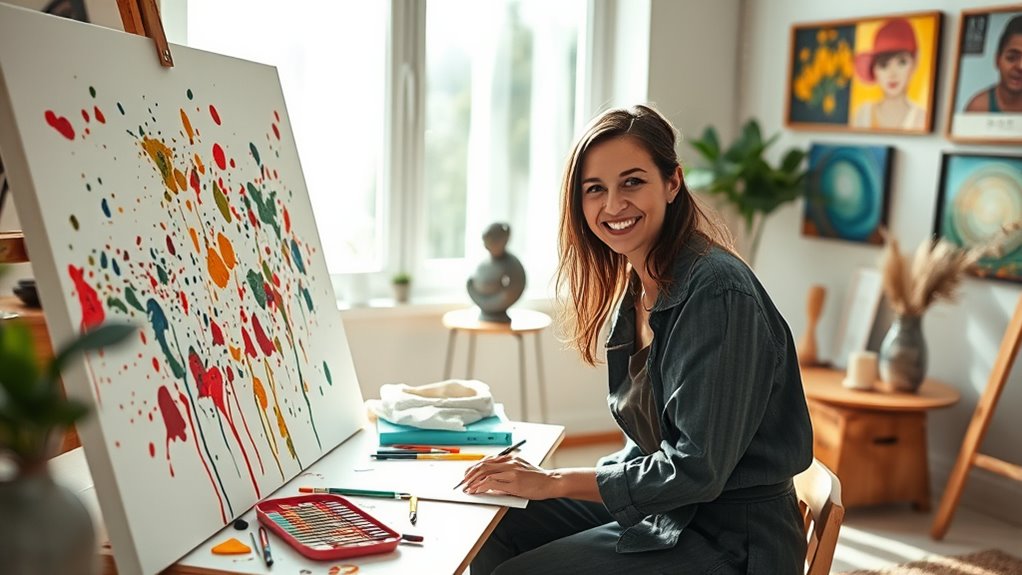
Building on how creative activities support emotional expression and mental health management, exploring various artistic practices in therapy reveals a wide array of approaches tailored to individual needs.
Art therapy often involves visual arts like drawing, painting, collage, and pottery to encourage self-discovery and emotional release.
Other creative activities, such as music, dance, and drama, allow you to explore feelings non-verbally and improve sensory integration.
Artistic practice also includes symbolic and kinesthetic processes that help access subconscious thoughts and aid trauma healing.
The use of diverse media can be customized to suit your preferences, cultural background, and therapeutic goals.
This variety ensures that you find the most effective method for your unique journey toward emotional resilience and cognitive growth.
- Visual arts: drawing, painting, collage, pottery
- Music, dance, drama for non-verbal expression
- Symbolic and kinesthetic art processes
- Tailored media for individual needs
The Science Behind Art’s Impact on Brain Function
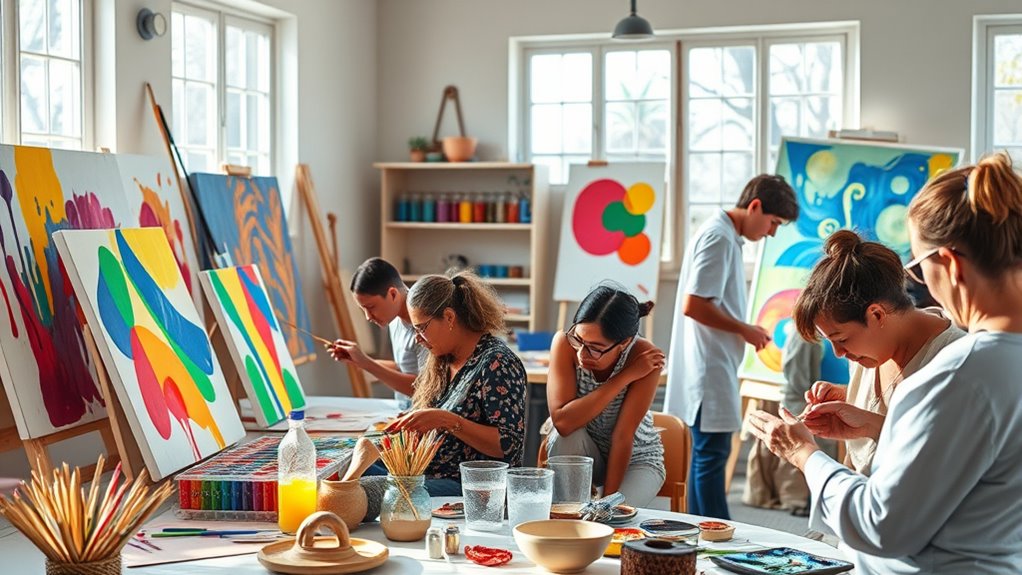
Engaging in artistic activities directly influences brain function by activating multiple neural pathways involved in emotion, perception, and movement. Neuroimaging studies reveal that art-making stimulates diverse brain regions, including visual processing, motor control, and emotional regulation centers.
This increased brain activity boosts serotonin levels, improving mood and emotional stability. Additionally, engaging in creative expression promotes neuroplasticity, helping your brain form new neural connections that support healing and cognitive flexibility.
Regular involvement in art enhances memory and executive functions while reducing symptoms of mental health disorders. By fostering these neural changes, art becomes a powerful tool for mental well-being, demonstrating how creative activity can reshape your brain and strengthen its capacity for resilience and adaptation.
Art Therapy for Different Age Groups and Populations
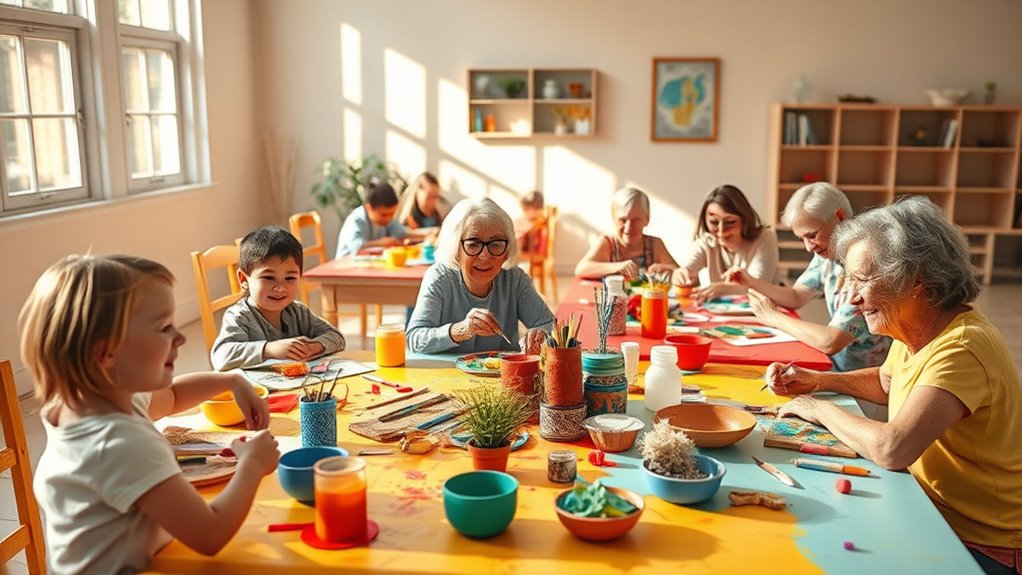
Have you ever wondered how creative activities can support emotional and cognitive growth across different ages? Art therapy adapts to each age group, offering tailored activities to boost mental health at every stage.
For children, it helps express feelings they can’t verbalize, aiding trauma processing. Teenagers use it to manage stress, explore identity, and address mental health challenges. Adults find new coping strategies and process complex emotions through art therapy.
Seniors benefit from cognitive support like delayed decline and memory improvement, alongside emotional well-being.
- Tailored activities for each age group
- Emotional regulation in children and teens
- Cognitive and memory benefits for seniors
- Mental health support across all ages
Art therapy’s versatility makes it an effective tool for promoting well-being across diverse populations.
Incorporating Art Into Daily Stress Management Routines
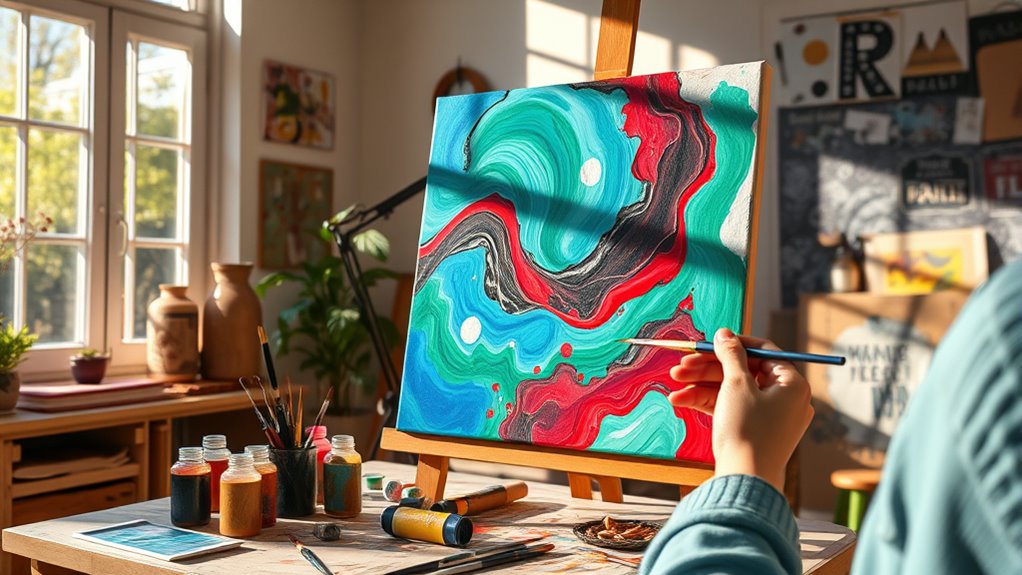
Incorporating art into your daily routine offers an effective way to manage stress and enhance overall well-being. Engaging in activities like drawing, coloring, or crafting can lower cortisol levels and reduce stress hormones, helping you feel calmer.
Short, creative breaks during busy days boost your mood and promote relaxation, making it easier to handle daily pressures. Regular artistic expression provides a safe outlet for emotional regulation, allowing you to process worries and frustrations constructively.
Using art as a mindfulness practice shifts your focus away from stressors, fostering present-moment awareness. Simple projects at home or work can strengthen your mental resilience, making stress more manageable.
The Professional Training and Setting of Art Therapists
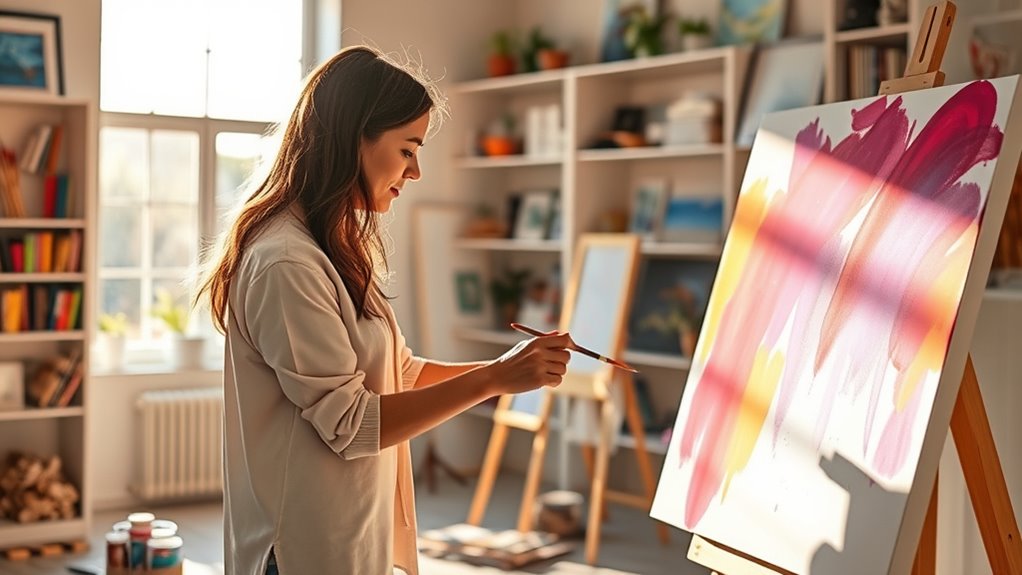
As someone interested in art therapy, it’s important to know that professionals in this field complete rigorous training and earn specialized certifications.
They work in a variety of settings, from hospitals to community centers, adapting their approaches to each environment.
This diverse practice requires ongoing education to stay current with best practices and ethical standards.
Specialized Certification Requirements
What qualifications do art therapists need to guarantee they’re prepared to provide effective mental health support? Certification ensures they meet professional standards and possess the necessary skills. To achieve this, you must complete specialized training that includes coursework in psychology, ethics, art therapy techniques, and cultural competency.
Supervised clinical practice hours are also essential to gain hands-on experience. Credentials like the Registered Art Therapist (ATR) or Board Certified Art Therapist (ATR-BC) are granted by the Art Therapy Credentials Board (ATCB) and signal your professional readiness. These certifications are crucial to establishing credibility and maintaining ethical standards.
Keep in mind that ongoing education and adherence to guidelines from the American Art Therapy Association (AATA) help ensure your skills stay current and effective.
Diverse Practice Environments
Art therapists develop their expertise through specialized training that prepares them to work effectively in a variety of settings. You’ll find them in diverse environments like hospitals, schools, veteran’s clinics, private practices, and community health centers. This variety allows you to serve different populations, including children, seniors, or those with mental health conditions.
As mental health professionals, they follow strict ethical standards and complete supervised clinical experience to ensure culturally competent and effective treatments. Their professional training combines coursework and hands-on practice, equipping you to adapt your methods to different environments and client needs.
This versatility in practice settings enhances your ability to make a meaningful impact, no matter where you work.
Personal Growth and Self-Discovery Through Artistic Expression
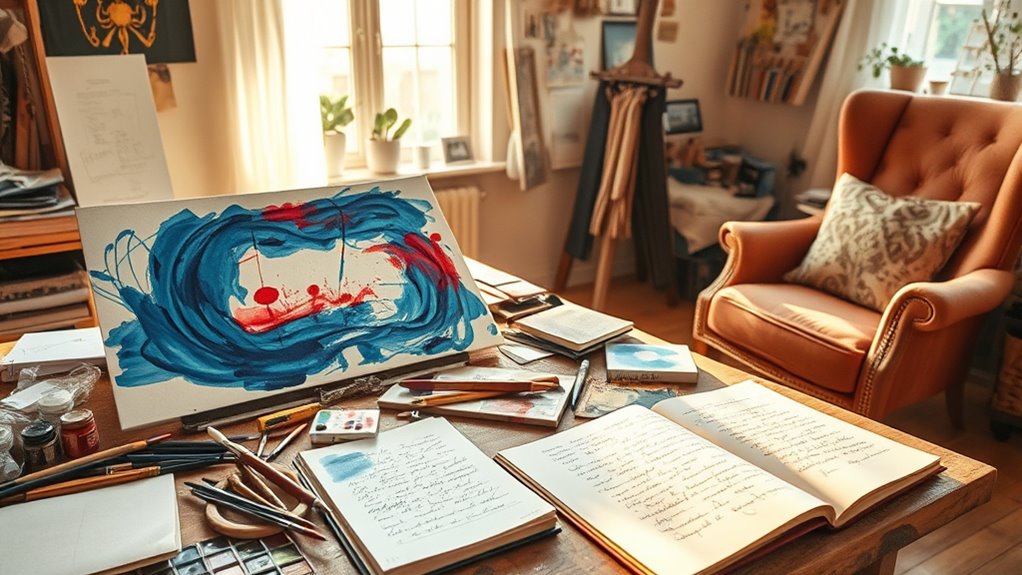
Engaging in artistic expression can serve as a powerful tool for personal growth and self-discovery. When you create art, you enhance your self-awareness by exploring your emotions and personal experiences.
The creative process helps you uncover underlying feelings and patterns in your behavior. As you complete each piece, your self-esteem and confidence grow through a sense of accomplishment.
Artistic activities also provide a safe, non-verbal outlet for self-discovery, especially if verbalizing your thoughts is difficult. Regular engagement encourages emotional resilience and personal insight.
- Explore emotions and experiences
- Boost confidence through achievement
- Uncover underlying feelings and patterns
- Use art as a safe outlet for self-discovery
Frequently Asked Questions
What Are the Therapeutic Functions of Art?
The therapeutic functions of art allow you to express emotions you might struggle to put into words. When you engage in creative activities, you reduce emotional conflicts, gain self-awareness, and promote healing.
Art stimulates positive feelings and helps regulate emotions, providing a safe space to process trauma, stress, or mental health challenges like depression and anxiety.
What Is the Therapeutic Power of Art?
They say a picture is worth a thousand words, and that’s true for art’s therapeutic power. When you engage creatively, you express emotions beyond words, explore your inner thoughts, and boost your mood.
Art activates neural pathways that help regulate feelings, reducing stress and anxiety. You connect with yourself through sensory and symbolic experiences, fostering healing and growth—showing that sometimes, actions speak louder than words.
What Is Therapeutic Value in Art?
Therapeutic value in art refers to how creating or engaging with art helps you express emotions, reduce stress, and improve mental health.
When you make art, it activates chemicals like serotonin, boosting your mood. It also fosters self-awareness and resilience, helping you understand and manage inner conflicts.
Who Does Art Therapy Benefit the Most?
You might wonder who benefits most from art therapy. It’s especially helpful if you have communication challenges, trauma, or neurological conditions like dementia or stroke.
Children and teens find it a safe way to express tough emotions, while older adults use it to boost memory and cognitive function.
If you’re dealing with chronic illness, art therapy can also help manage pain, anxiety, and depression effectively.
Conclusion
By embracing art in your life, you reveal a powerful tool for healing and self-discovery. Whether you’re managing stress, exploring emotions, or simply seeking joy, creative expression offers profound benefits. Are you ready to explore how art can transform your well-being? Remember, you don’t need to be an artist—just open yourself to the possibilities and let your inner world flourish through creative activity. The therapeutic power of art is waiting for you to experience it.





